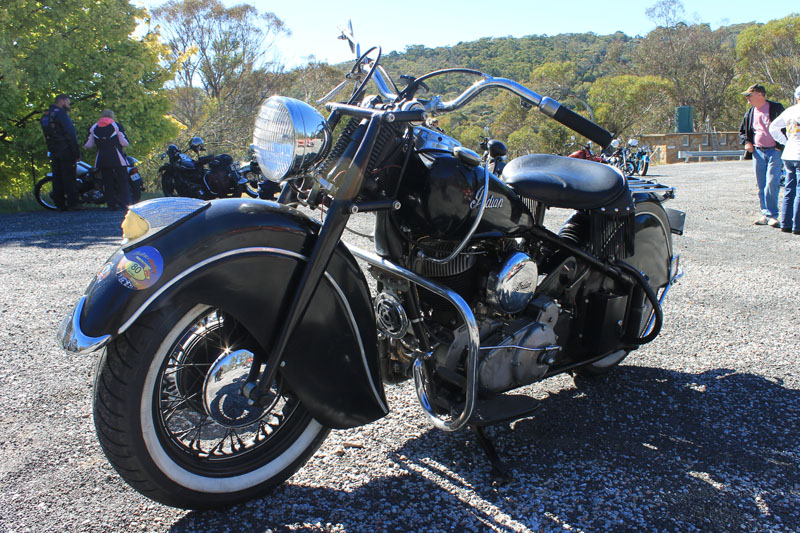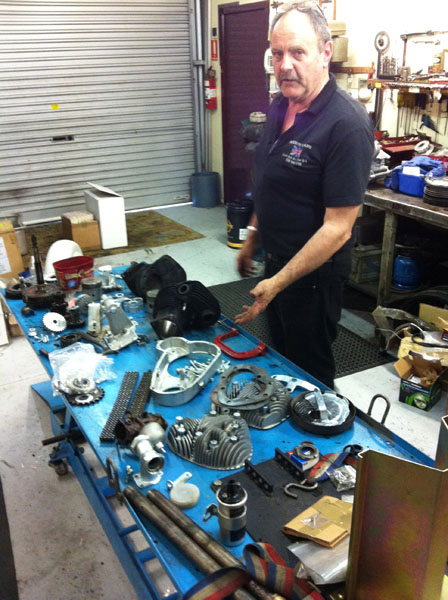Motorcycle Investor mag
Subscribe to our free email news

Our bikes - 1947 Indian Chief
(from MT269 circa April 2013 - look for the video at the end)
by Guy 'Guido' Allen
Indian Summer
What better way to round off the hot end of the year than adding another toy to the shed?
A few years ago, I could have told you what an Indian motorcycle was, but had never actually thrown a leg over one. Now there are two sitting in the shed.
It’s harsh but fair to blame well-known trade identity Phil Pilgrim, of Union Jack Motorcycles, for this. The story began early in 2011 when he arranged for me to borrow a 2003 Indian Chief Vintage. Of course I ended up buying it and haven’t regretted the decision, even though – up till then – it was by far the most expensive motorcycle I’d acquired.

Move on to early 2012, and he’s done it again. This time throwing me at a well-worn but functional 1948 Chief, aka Black Bastard (above), which I end up riding in the 25th annual Great Race. (That’s a reliability trial for vintage and classic Indians and Harleys, run over a couple of days in the Snowy Mountains.) It was easily the best time I’ve ever had on a classic motorcycle – fan-bloody-tastic.
It would cruise happily at 50-60mph (80-100km/h), was more comfortable than many modern cruisers and felt surprisingly robust. The challenges? Getting your head around a clumsy rocker foot clutch and hand shifter for a three-speed crash box were the main ones. That, plus remembering to use the manual advance/retard. Not impossible – just requiring a little practice.
While Black Bastard would have been welcome to find a warm and dry place in my shed and, dangerously, was for sale, I couldn’t afford it. I still can’t.

While quietly hankering after another Chief of similar vintage, the situation came to a head late last year when I made the mistake of calling Pilgrim about something that was totally unrelated. He casually mentioned that one of his own Indians (a 1947 model) was up for sale, including a fresh engine. I asked how much, lost the power of speech thanks to the size of the number, hung up and thought about it.
The newly-built powerplant was a big attraction, particularly since it was being done by a professional and I could specify what I wanted in it. It’s an ideal way to start a relationship with a classic motorcycle.
After some frantic and very dodgy financial calculations involving selling stuff and not eating for a considerable period of time, I rang back and became the new owner – sort of. There was the small matter of raising the money, which ended up taking marginally less time than it did to build a fresh powerplant.
THE BUILD
Something that didn’t occur to me until well into the process was that this represented a unique opportunity. Every other time I’ve bought a motorcycle over the years (with exception to the odd basket case), it’s been a complete unit and usually running. So when it’s come to repairs and maintenance, I’ve had to learn its architecture and peculiarities from scratch.
With something like Winston, the sodding 1947 Sunbeam, that’s presented more than its fair share of challenges. This time, I actually got to see the workings of the thing while it was being built up, and was even involved in the final assembly, when Pilgrim needed some muscle (but not brains, apparently…) to hoist the engine into the frame.

The former TAFE teacher in him came out at one stage, when he laid out a complete engine and transmission, then patiently walked me through the components and their peculiarities. For example, the relatively loose clearance on the valve guides would be alarming in a modern motor but fine in this.

His reasoning behind this and the care taken with the build was simple. “When you walk out to the garage, I want you to think ‘I’ll take the Indian today’ and be comfortable with it,” he said.
It’s at this stage you realise how old and simple the powerplant really is. Indian did the first iteration of the side-valve 1200 (74 cubic inch) twin in 1923, upgrading it through the thirties. It remained in service (albeit with some performance mods) right through to the closure of the Springfield factory in 1953. Arch-rival Harley-Davidson meanwhile had developed two whole new engine series, Knuckleheads and Panheads, over the same 1930s to 1950s period.
One of the early decisions was what did I want in the mechanical package? Ex-factory upgrades included more aggressive Bonneville cams, higher compression (from 5.2:1 to a heady 6.2:1) and a capacity lift to 80 cubic inches (1300cc). Plus, there is a huge range of aftermarket offerings including a four-speed gearbox, 12-volt conversion (from 6-volt) and even electric start.

Something I observed since my induction into the Indian ‘tribe’ in 2011 is the engine upgrades had a tendency to produce a package that was more difficult to start, the four-speed boxes had a reliability question mark over them and the electric boots were at best fragile. In contrast, Black Bastard, which was an unmolested 1200, was easy to get going and a perfectly amiable companion. Okay, the 80-cube bikes often swept past me, but I preferred the gentle reliability of the standard package. Hannibal, my 220hp Hayabusa, is more than happy to oblige if I want to go fast.
So, with a request for keeping it bog standard, thanks, Pilgrim got the show on the road. Murray Morell in Western Australia did the bottom end for us, essentially checking and rejuvenating the crank and rod assembly.
From there, Pilgrim built up the powerplant with a host of new and restored components. The process, like a lot of these things, looks straight-forward if you know what you’re doing – there are however one or two traps for the inexperienced.

A lot of the ancillaries are from a different age and mindset. For example the Linkert carburetter looks like a glorified lump of gas pipe, with a couple of adjustment knobs. One is for idle and the other for fast-running.
Then there’s the belt-driven generator which, despite its enormous size, has a very modest output. Our rebuilt version turned out to be unreliable (not unusual for these units) so we swapped it over for a modern 12-volt alternative.
A critical check on this model is the girder front end, which has a host of pivots that can flog out. This one had only recently been done.

SADDLE UP
I’ve so far only had a couple of rides on the Chief, which daughter Ms A Junior promptly christened Sheba (Queen of the Shed). It’s a promising start that I can, with a touch of luck, walk out and it will fire up on the first kick.
More importantly, I know from experience with Black Bastard that they can be reliable. Though a tired example, it ran faultlessly over a couple of days and a few hundred kilometres across an at times challenging course. (Well, challenging for a motorcycle looking forward to its 70th birthday.)
Getting your head around riding it is the biggest trick. The foot clutch takes some getting used to, though you soon learn to forget finessing it, just let the sheer grunt of the lazy powerplant do its job. Between that, the hand shift and the manual advance on the left twistgrip, you can get busy.
Still, it could be worse. A lot of this generation Indian run a left-hand throttle and right-hand shift.
I’ve mentioned they’re comfortable and that’s because they’re effectively double-suspended, with primitive plunger shocks on the rear plus a suspended and generously-proportioned saddle.

Braking is reasonable on the back and woeful on the front. One of the ironies of this model Chief is the front brake is pathetic, which encourages people to hang on to it on long downhill runs. Do that, and it will eventually overheat and seize! Pilgrim is working on casting a run of modified Triumph units, and I’m lining up for one.
While it was a low, long and heavy (260kg) bike for its day, which made it stable, it’s dwarfed by modern cruisers, particularly my 2003 model. Steering is slow and predictable. It will get unruly over the odd set of bumps, but you’re fine if you just sit there and let it sort itself out.
Fuel range is pathetic thanks to small tanks and a prodigious thirst. You soon learn the first rule of classic Indian ownership: never pass a bowser without using it.
The colour scheme is worth a mention. Indian was owned for a while by paint company Du Pont, which meant you could order any colour mix you liked for very little extra. So there were some wild and woolly combos out there. The Indian Red and cream livery on this bike, with metallic silver pinstriping (which fits the period, but is unique), is done by Ray Drever near Geelong, Victoria. He’s justifiably famous in hotrod circles for his work and the whole lot is done in enamel. Not cheap, but it lasts.
There’s a tendency just after you’ve bought a motorcycle to defend to the death the validity of your decision. However I’ve bought and sold so many in recent years that I’m developing an immunity to the inevitable jibes and baffled looks when you announce the latest acquisition to your mates. Though the cost was substantial, it was great value, and I’m very comfortable with the choice.
As for Pilgrim – mate, thank you, the bike is a treasure. But I’m sorry, I just can’t afford to talk to you any more…

Indian web
IndianMotorcycles.com.au
Local site for the revived American brand
IronIndian.com.au
Very active club that accepts Indians of all ages.
IndianMotorcycleClub.com.au
Springfield Indians (up to 1953).
***
Indian books
Indian Motorcycle Restoration Guide: 1932-53
Author: Jerry Hatfield; Publisher: Motorbooks International
Regarded as ‘the’ resto guide for the era.
Franklin’s Indians
Authors: Harry V Sucher and others; Publisher: Panther
Fascinating tale of Irish racer Charles B Franklin, the ‘father’ of the Scout and the Chief.
The Iron Redskin: The history of the Indian motorcycle
Author: Harry V Sucher; Publisher: Haynes
One of the ‘must-haves’.
Build & first engine run video
-------------------------------------------------
Produced by AllMoto abn 61 400 694 722
Privacy: we do not collect cookies or any other data.

Archives
Contact



